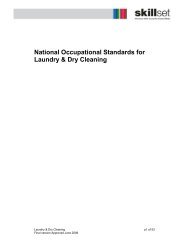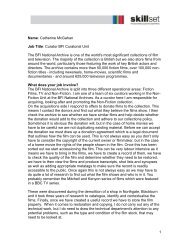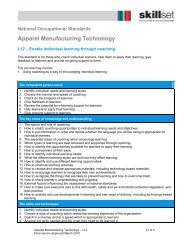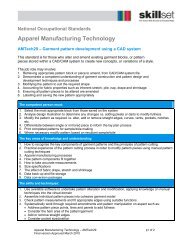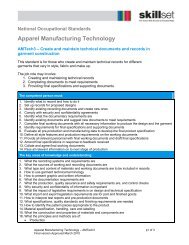Publishing in the Knowledge Economy - DTI Home Page
Publishing in the Knowledge Economy - DTI Home Page
Publishing in the Knowledge Economy - DTI Home Page
You also want an ePaper? Increase the reach of your titles
YUMPU automatically turns print PDFs into web optimized ePapers that Google loves.
Issues for competitiveness<br />
<strong>Publish<strong>in</strong>g</strong> <strong>in</strong> <strong>the</strong> knowledge economy<br />
16.1 Better understand<strong>in</strong>g and servic<strong>in</strong>g<br />
<strong>the</strong> end customer<br />
The understand<strong>in</strong>g of <strong>the</strong> customer’s habits and<br />
use of <strong>in</strong>formation is vital <strong>in</strong> deliver<strong>in</strong>g <strong>the</strong> right<br />
type of <strong>in</strong>formation to him at <strong>the</strong> right time <strong>in</strong> <strong>the</strong><br />
right context. Fur<strong>the</strong>rmore, establish<strong>in</strong>g a closer<br />
relationship enables better profil<strong>in</strong>g for<br />
advertisers which is essential if <strong>the</strong> forecast step<br />
<strong>in</strong>crease <strong>in</strong> direct mail advertis<strong>in</strong>g is not to turn<br />
<strong>in</strong>to a threat due to <strong>the</strong> <strong>in</strong>creased availability of<br />
techniques to major corporations and retailers <strong>in</strong><br />
identify<strong>in</strong>g consumer usage patterns.<br />
16.1.1 Strengths and opportunities<br />
There has been a recognition by publishers of<br />
<strong>the</strong> need to get closer to <strong>the</strong>ir end-users; 50%<br />
and 64% of <strong>the</strong> respondents to our survey<br />
<strong>in</strong>dicated gett<strong>in</strong>g closer to <strong>the</strong> customer as<br />
be<strong>in</strong>g an opportunity with great potential for<br />
<strong>the</strong>ir bus<strong>in</strong>ess <strong>in</strong> three years and 10 years<br />
respectively (Figures 16.1 and 16.2).<br />
The wide-adoption of Internet market<strong>in</strong>g<br />
technologies by most publishers (as evidenced<br />
by <strong>the</strong> e-commerce impact assessment) has<br />
pushed both small and large publishers closer<br />
to <strong>the</strong> customer.<br />
The newspapers and consumer magaz<strong>in</strong>e<br />
<strong>in</strong>dustries have focused on reader groups which<br />
has enabled <strong>the</strong>m to collect good statistics on<br />
<strong>the</strong>se groups and develop brands. This forms<br />
<strong>the</strong> basis for extension to more targeted<br />
knowledge about <strong>the</strong> read<strong>in</strong>g and buy<strong>in</strong>g habits<br />
of <strong>the</strong>se end customers.<br />
The bus<strong>in</strong>ess publishers, <strong>in</strong>clud<strong>in</strong>g magaz<strong>in</strong>es<br />
and directories, have started tailor<strong>in</strong>g <strong>the</strong>ir<br />
products to <strong>in</strong>dividual users. The bus<strong>in</strong>ess<br />
model here has enabled <strong>the</strong> revenue streams to<br />
cont<strong>in</strong>ue to flow from corporate or <strong>in</strong>stitutional<br />
sources while o<strong>the</strong>r sources of revenue have<br />
been derived from additional services sold to<br />
<strong>the</strong> end user. Many bus<strong>in</strong>ess publishers have<br />
created new end-user services attached to <strong>the</strong>ir<br />
traditional brands which are result<strong>in</strong>g <strong>in</strong> gett<strong>in</strong>g<br />
closer to <strong>the</strong> end customer and generat<strong>in</strong>g<br />
<strong>in</strong>creased revenues.<br />
16.1.2 Challenges<br />
Publishers almost across <strong>the</strong> board have not<br />
sold directly to end-users, but <strong>in</strong>stead use<br />
<strong>in</strong>termediaries for <strong>the</strong> sell<strong>in</strong>g and distribution<br />
processes. This has built relatively efficient and<br />
cost effective supply cha<strong>in</strong>s, but has led to <strong>the</strong><br />
culture of, as a book publisher said, “let’s push<br />
as much as we can out <strong>the</strong>re, and hope<br />
someone will buy it”. This has been less so <strong>in</strong><br />
<strong>the</strong> case of magaz<strong>in</strong>es and newspapers, but<br />
even here <strong>in</strong>formation has been collected <strong>in</strong><br />
terms of user groups ra<strong>the</strong>r than <strong>in</strong>dividual<br />
users, ma<strong>in</strong>ly for <strong>the</strong> purposes of driv<strong>in</strong>g<br />
advertis<strong>in</strong>g revenue ra<strong>the</strong>r than understand<strong>in</strong>g<br />
<strong>the</strong> needs of <strong>the</strong> reader better and develop<strong>in</strong>g<br />
an ongo<strong>in</strong>g relationship with <strong>the</strong>m. This is<br />
becom<strong>in</strong>g more important as demands on<br />
consumers’ time grow and loyalty weakens.<br />
The ability to target customers with<br />
contextualised, time sensitive content is<br />
essential to <strong>the</strong> successful exploitation of<br />
content on new platforms <strong>in</strong>clud<strong>in</strong>g ward<strong>in</strong>g off<br />
<strong>the</strong> threat of free onl<strong>in</strong>e content. To do this,<br />
customers must be profiled very accurately and<br />
carefully. (See ‘Achiev<strong>in</strong>g a better balance <strong>in</strong><br />
revenue streams’, Section 16.3.) There will be<br />
an <strong>in</strong>creas<strong>in</strong>g need to understand what<br />
consumers and professional <strong>in</strong>formation users<br />
do on <strong>the</strong> Internet and how <strong>the</strong>y use <strong>the</strong><br />
medium. This is helped by <strong>the</strong> use of new<br />
technology which enables <strong>the</strong> easier profil<strong>in</strong>g.<br />
The <strong>in</strong>dustry also needs to address <strong>the</strong> way it<br />
currently licences content to third parties and<br />
customers. As <strong>the</strong> <strong>in</strong>dustry removes <strong>the</strong><br />
wrappers from its content it is important to make<br />
it easy for customers to licence and re-use <strong>the</strong><br />
content. There are two ma<strong>in</strong> aspects to this.<br />
1. Mak<strong>in</strong>g <strong>the</strong> deal to use content must be<br />
made simpler. The use of Digital Rights<br />
Management technology will help<br />
standardise licences and control of <strong>the</strong> terms<br />
made by <strong>the</strong> publisher and understood and<br />
adopted by licensees and customers. There<br />
are however, different licens<strong>in</strong>g bodies at<br />
present for books and magaz<strong>in</strong>es on <strong>the</strong> one<br />
hand, and newspapers on <strong>the</strong> o<strong>the</strong>r. The<br />
<strong>in</strong>dustry should make an attempt to ><br />
101



